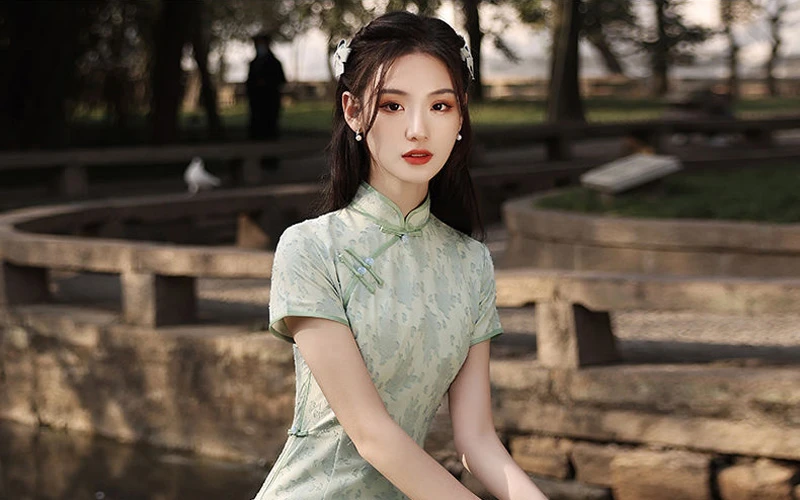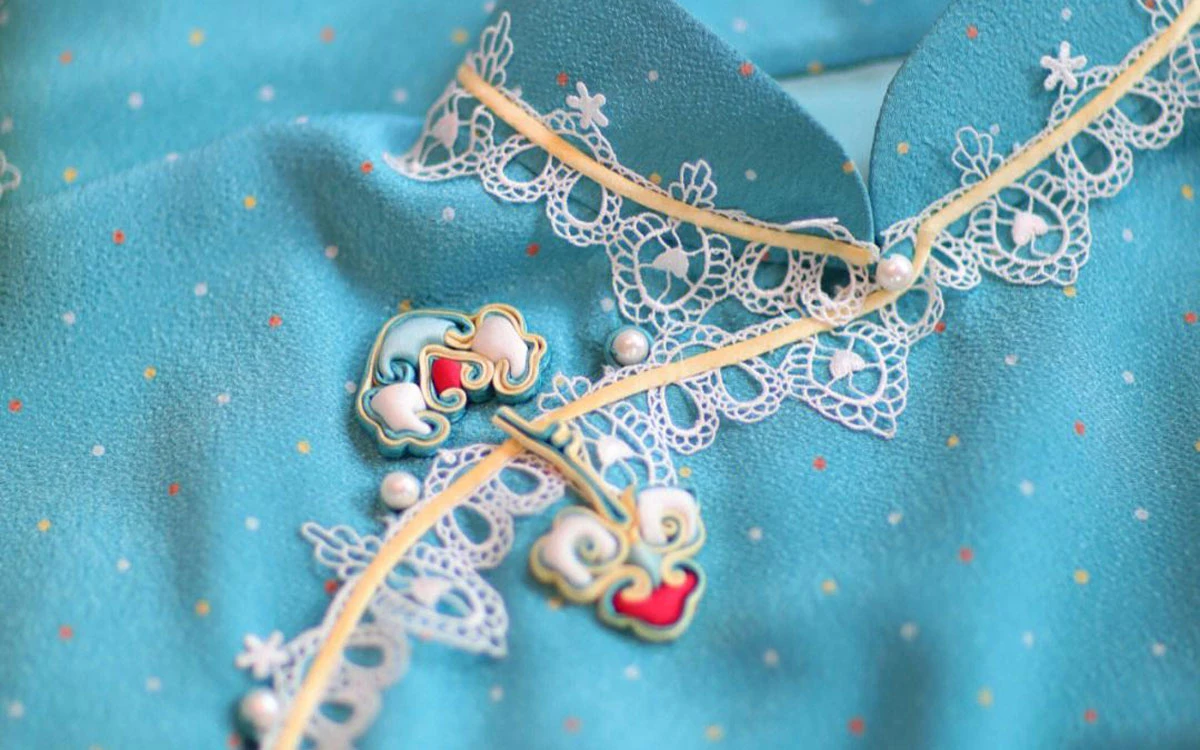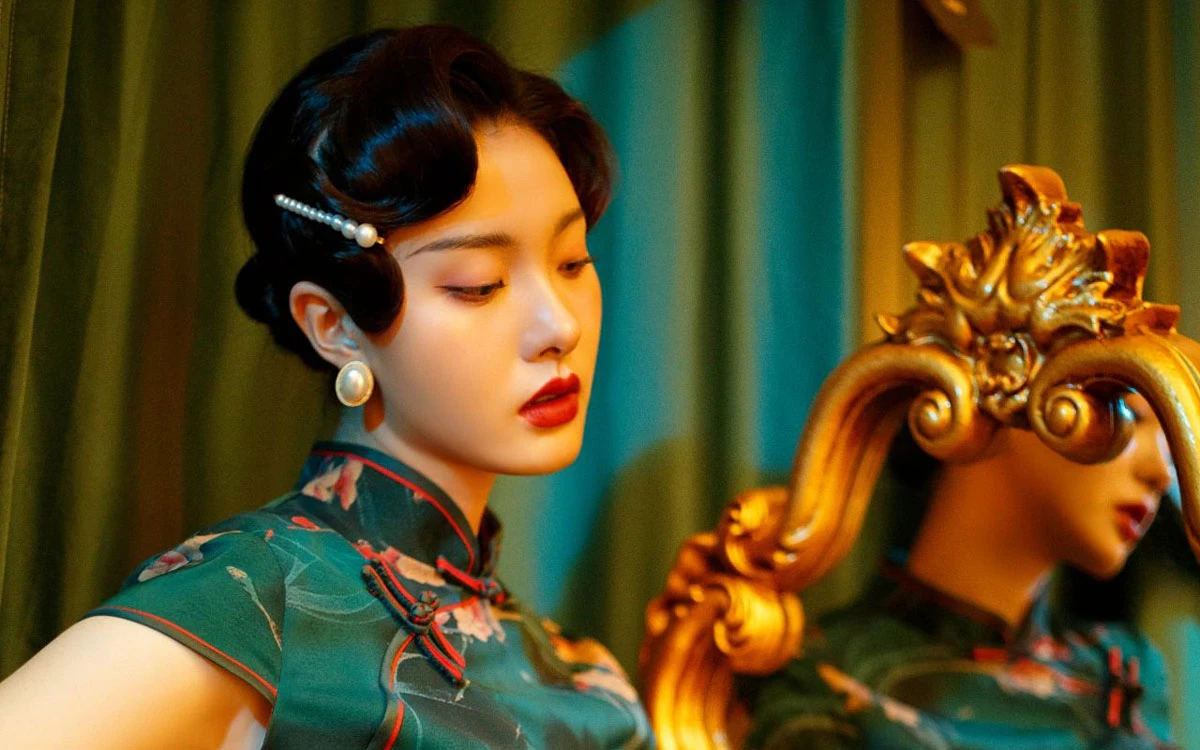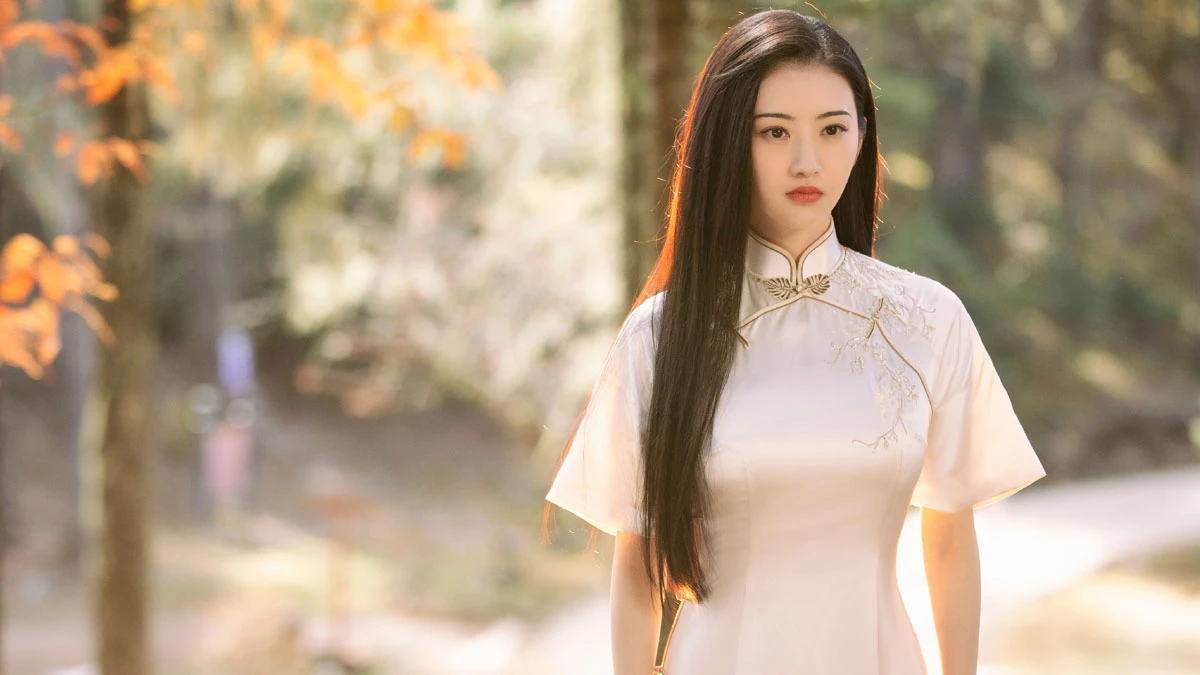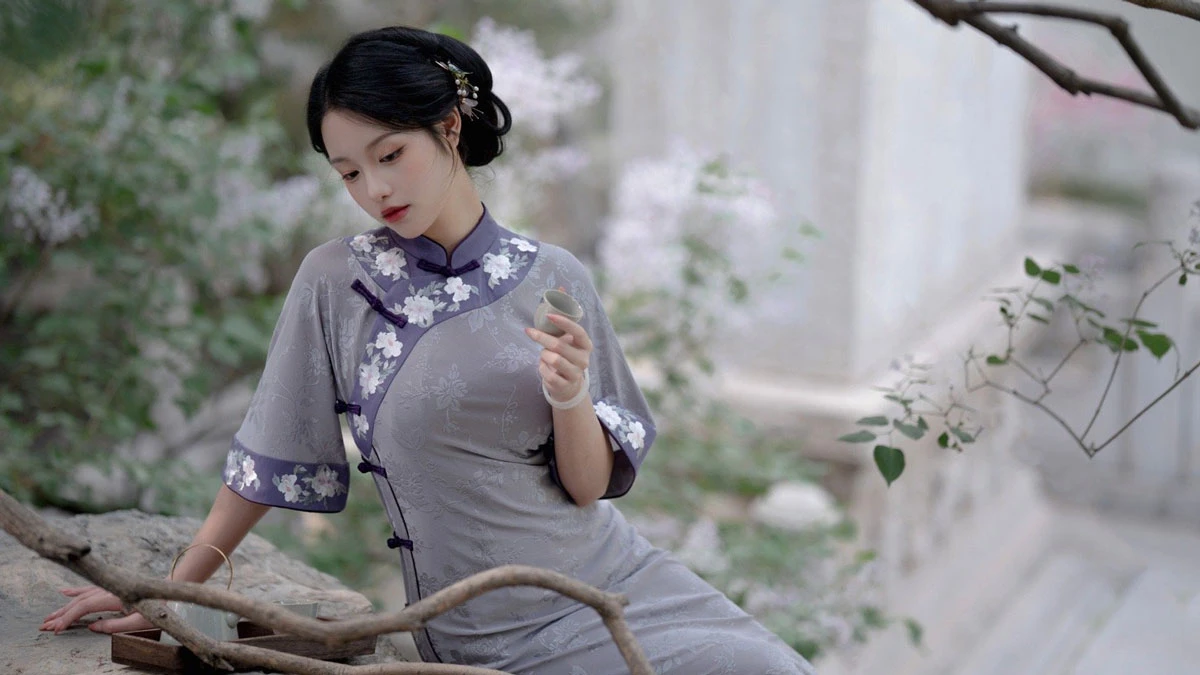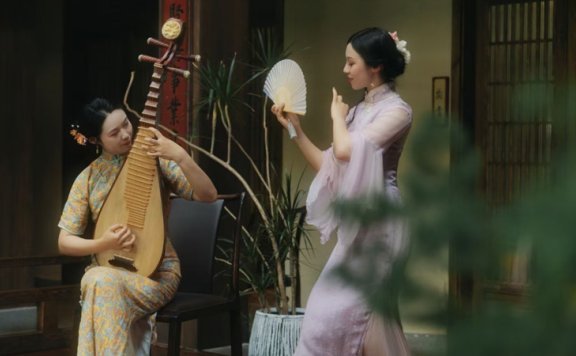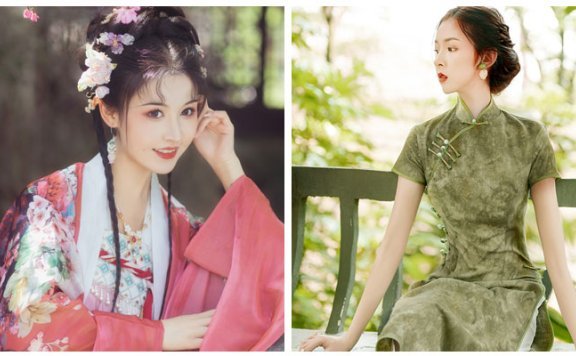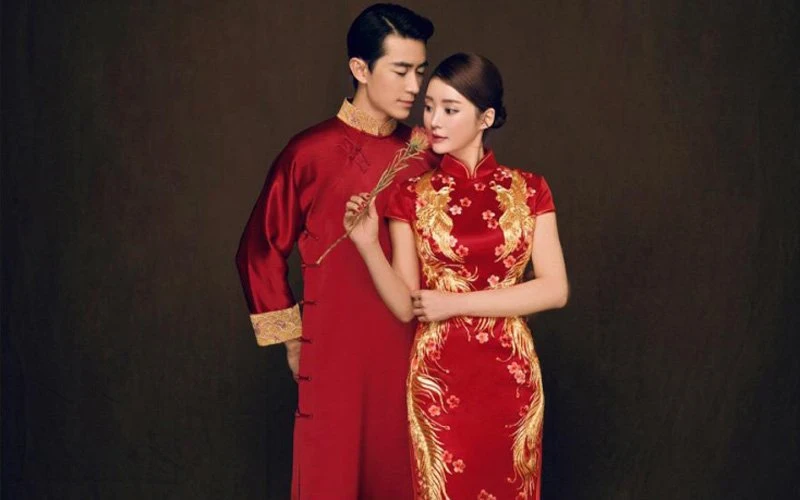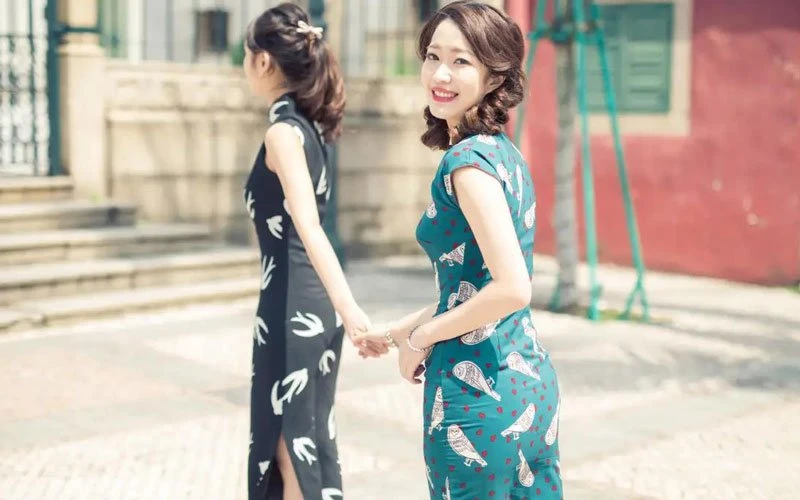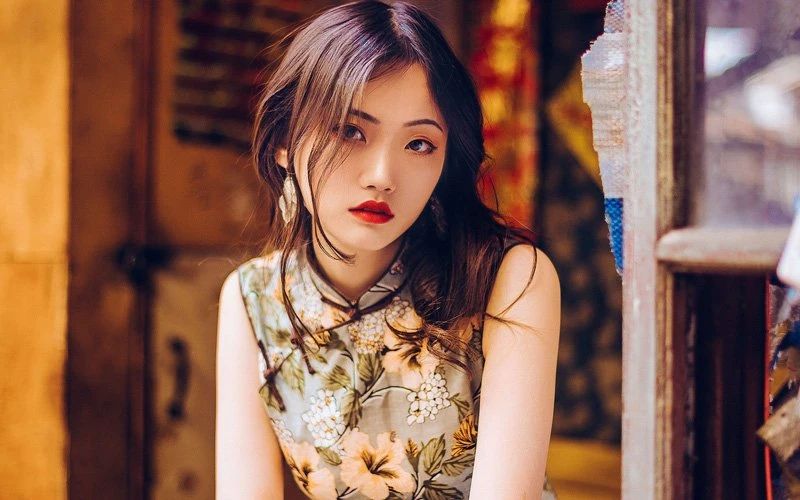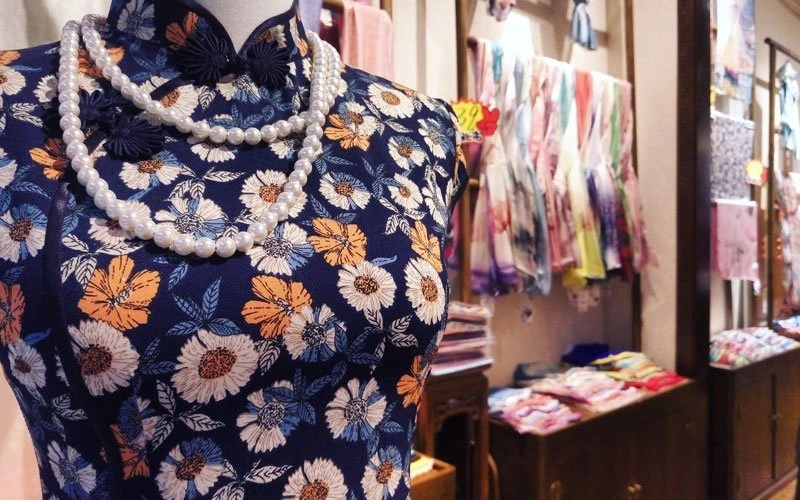-
Chinese Cheongsam Lapel Forms: Characteristics and Occasions to Wear Them
The lapel, as an essential component of the cheongsam dress, serves as a critical dividing line in the layout of its style, possessing both functional and ornamental purposes. It complements the collar, buttons, or overlapping pieces in a harmonious manner, thus showcasing the overall beauty of the Qipao. The lapel (Jin, 襟), also known as the opening of the garment, is the unfastening of the Qipao's garment. Changes in the lapel are one of the primary way in which the Qipao's style evolves. Today, let us appreciate the modern styles of Qipao's lapels and savor the charm of Eastern women. Without Lapel One of the most concise ways of opening a cheongsam is the "Without lapel, 无襟, Wu Jin" style. This kind of lapel style is directly derived from traditional Chinese clothing, appearing dignified and traditional. Pleated & Without Lapel "Pleated without lapel, 褶皱无襟, Zhezhou & Wu Jin" style adds decorative pleats to the front chest, simple yet sophisticated, enhancing the sense of fashion. Round Lapel "Round lapel, 圆襟, Yuan Jin" is the most common style of modern cheongsam lapel, with smooth lines from the neckline to the armpits. Depending on the size of the arc, it can… -
The Ultimate Guide to Cheongsam Button - Pan Kou
In history, there have been many beautiful clothing styles in every period, such as the Chinese cheongsam, which has formed a unique clothing culture, and the Pan Kou, which was born in response, has gradually developed from an ancient sash to a cheongsam accessory that is both practical and decorative, thus forming a unique handcrafted skill. 01 Origin of Pan Kou The button of the cheongsam is called Pan Kou (盘扣, Chinese frog closures) or Pan Niu (盘钮), which is a kind of button used in traditional Chinese clothing, used to fasten the lapel or decoration, it is developed from the ancient Chinese knot. The Bei Zi (褙子) unearthed in the Southern Song tomb in De'an, Jiangxi, was tied with Pan Kou. This shows that as early as the Song Dynasty in China, people used Pan Kou to fasten loose clothes. The role of Pan Kou in the evolution of Chinese clothing has changed, it not only has the function of connecting the lapels, but is also known as the finishing touch to decorate clothing. It vividly expresses the decorative interest of Chinese costumes that emphasize meaning, connotation, and theme. 02 The production and types of cheongsam button…- 1.1k
- 3
-
The Perfect Accessories to Elevate Your Cheongsam Outfit
Are you looking to add some extra flair to your cheongsam outfit? Cheongsams are already a stunning traditional Chinese dress that exudes elegance and grace, but with the right accessories, you can take your outfit to the next level. Whether you're attending a formal event or simply looking to spice up your daily wardrobe, the right accessories can make all the difference. From jewelry, hats to handbags, there are many options to choose from. Here are some of the best accessories to match with your cheongsam. 01 Shawl A shawl can be a beautiful accessory to pair with a cheongsam outfit. One of the advantages of wearing a shawl with a cheongsam is that it can add an extra layer of warmth and comfort, especially if the dress is made of lightweight fabric. Additionally, a shawl can add a touch of elegance to the outfit, especially if it is made of luxurious fabric such as silk or cashmere. Another advantage of wearing a shawl with a cheongsam is that it can be used to add some color and texture to the outfit. A brightly colored or patterned shawl can complement the dress and create a beautiful contrast. It can…- 3.1k
- 0
-
Unveiling the Beauty and History of the Iconic Qipao Dress
Recently, Zhou Xun's Qipao (旗袍, cheongsam) dress look in the movie "Hidden Blade" brought this traditional costume back into the spotlight. If it is said that every era has representative clothing, then, the Republic of China women's closet must not be missing one cheongsam. 01 Fashionable clothing in the Republic of China period Qipao dress can be said to be the most representative clothing in the Republic of China. For social needs, the ladies also often update cheongsam style. Song Meiling often wore cheongsam, when she went to the United States to seek support for the war, especially when she spoke in the U.S. Congress, the image of a black satin cheongsam stunned the crowd, while boarding the major U.S. magazines. The popularity of the cheongsam owes much to the successful incorporation of practical Western elements without losing traditional Chinese features. Although designated as one of the Chinese dresses, the Qipao dress is actually a Western-style wear under a Chinese-style appearance. On the outside, the Qipao dress still adheres to the traditional Chinese elements such as silhouette, Pankou, and vertical collar, and the custom of "right overlapping" is also retained, which constitutes the unique aesthetic form of the Qipao… -
The Art of Cheongsam Collar: An Exploration of the Different Styles and Their Feature
Cheongsam, as one of the traditional Chinese dresses, can be seen as one of the tags of oriental women. It is like an ink-scented rice paper, which writes the history of Chinese dress, and like an inscription of the ancient time, even the folds of which contain the scent of ancient culture. It is not only a garment, but also a carrier of traditional Chinese culture. As one of the key elements of the composition of cheongsam, the collar shape has a very important influence on the style of cheongsam. Traditional cheongsam collar, often with a stand collar design, formed an elegant effect, with good effect in highlighting the lines of the female neck and body. The details of the cheongsam collar, show the workmanship, also the soul of the cheongsam. The right collar type can fit perfectly with the body, but also with the cheongsam as a whole, to the overall style of cheongsam into more exquisite aesthetic temperament, from the fundamental focus on temperament. The origin of the cheongsam collar The relationship between modern cheongsam and Qing dynasty Manchu robe is still controversial, but it is undeniable that there is an inextricable relationship between cheongsam and Qi… -
Tracing the Fascinating History of Cheongsam: From Qing Dynasty to Modern
For centuries, the cheongsam has been a symbol of elegance, femininity, and Chinese culture. Also known as qipao, this form-fitting dress has been worn by women in China and beyond, captivating the world with its stunning beauty and timeless charm. While the cheongsam is now a fixture on fashion runways and red carpets around the world, its origins and evolution tell a captivating story of cultural exchange, fashion innovation, and societal change. From its early beginnings in the Qing Dynasty to its modern-day reinventions, the history of the cheongsam is one of the most fascinating and enduring tales of fashion history. In this article, Hibetterme explores the rich history of the cheongsam, the characteristics of modified cheongsam, and how to pick the right style of cheongsam for you. The Evolution of cheongsam The origin of the cheongsam is actually quite controversial. Some scholars believe that it is the robe of the Qing Dynasty, and in the late Qing Dynasty and the early Republic of China, it gradually evolved into the current cheongsam due to social changes and the influence of Western culture. Some scholars also point out that the origin of cheongsam should be older than the Zhou, Qin,… -
The Origin of Cheongsam and Chinese Women Is the Memory of Stunning Times
01 The cheongsam loved by women Eileen Chang once said, "Clothes are a language", and every heroine in her novels would use the style of cheongsam to interpret the sorrow and happiness of love, and the prosperity of silk to lament the impermanence of fate. And Eileen Chang's love for cheongsam can be described as close to crazy. Cheongsam is not only an important prop in her novels, but also an indispensable costume in her life, and it is an expression of her views on life, aesthetics and women. The cheongsam maker who made her cheongsam recalled that he couldn't remember how many pieces of cheongsam he made for Eileen Chang, but he remembered that each piece of cheongsam was made "according to the drawing", and the design came from Eileen Chang herself. Not only Eileen Chang, but also Chinese women in the 1930s and 1940s seemed to be very fond of cheongsams. Soong Mei-ling was no less fond of cheongsams than Eileen Chang, and she had hundreds of cheongsams in her closet. Film and television stars such as Hu Die, Ruan Lingyu, and Zhou Xuan are also fans of cheongsam, they not only wear cheongsam out of their own… -
Hanfu vs Qipao, Cheongsam: What’s the Difference?
Hanfu vs Qipao, both are excellent representatives of traditional Chinese costumes. Hanfu (汉服), Han national traditional costume. Qipao (旗袍, cheongsam), the women's clothing of the Republican era. Whenever traditional Chinese clothing is mentioned, the cheongsam is usually the first thing that comes to mind. But with the expanding influence of Hanfu, a costume that better represents Chinese history is being preferred by more and more people. What exactly are the differences between the two costumes? 1. Hanfu vs Qipao in Different Origins Origin of Hanfu Ancient hanfu was the traditional clothing and accessory system of the Han Chinese from the time of the Yellow Emperor to the middle of the 17th century AD (late Ming and early Qing dynasties). Origin of cheongsam Cheongsam was formed in the 1920s and later became the most common women's clothing at that time, being one of the most splendid phenomena and forms in China's long-standing dress culture. The controversy of the origin of cheongsam There are still many controversies about the definition of cheongsam and the time of its production, focusing on the following. 1. It is believed that cheongsam is developed directly from the robe of Qing Dynasty. 2. It is believed…- 8.7k
- 1
-
How to Choose One Beautiful Qipao Dress for Chinese Wedding?
In a Chinese wedding, a suitably wore qipao dress not only shows the bride's delicate figure but also sets off her extraordinary temperament, which will be exclusive to the oriental woman's classical quality bloom definitely. The wedding ceremony is the most important ritual in the life of the new couple. In addition to a white wedding dress, the bride will choose a beautiful and fashionable qipao dress for the wedding occasion, so as to conveniently wear when thanking guests for the toast. Choose the bridal qipao dress that can be considered from the color, style, fabric, and personal figure, temperament and so on, and must not ignore the hair accessories, accessories, shoes, and other details factor. The Color of Qipao Dress Whether it's a Chinese wedding or a Chinese wedding dress, there's a preference for the festive big red, and the qipao dress is also the same one. When hosting a more Chinese wedding, choose a qipao dress in a big red color that can fit all brides. Brides who are tired of seeing red cheongsam can choose according to their own conditions. For example, a younger and fairer-skinned bride can choose a rose-red one. The dark is suitable for the…- 1.6k
- 0
-
Chinese Cheongsam Dress is a Beauty of Traditional Costume
Chinese cheongsam dress is a traditional costume of Chinese culture, after more than a hundred years of development, Chinese cheongsam dress has represented a unique symbol of the Chinese nation on the international stage. Chinese cheongsam dress, solemn and elegant, noble and romantic, it shows a woman's soft posture to the fullest, conveying a woman from the inside out or youthful, or mature and charming all kinds of styles, a lift of the hand and a look in the eyes, all present the beauty of excellence. · Qing Dynasty Cheongsam--The Flag Lady's Dress In the beginning, the Qing Dynasty Manchu female robe worn by the people called the " Flag Lady's Dressed ". From the Qing Dynasty to the Republic of China, starting in Beijing to Shanghai, through the evolution and improvement of history, it has become popular in recent and modern times, becoming known as " Chinese cheongsam dress ". · ROC ( Republic of China) Chinese Cheongsam Dress--The Beginning of the Trend After the Xinhai Revolution, by the influence of schoolgirls dress, top and bottom skirt of the "new civilization" popular for a while, the 1920s women's robes are popular again, after the development of a new style…- 1.8k
- 2
-
What is a Modern Cheongsam - Chinese Qipao Dress
The word Qipao originally meant "Qing People's Robe." But in modern day, cheongsam dress immediately conjures up images of the famous traditional Chinese outfit, an icon of Eastern Asian fashion and a symbol of Shanghai City, with an enduring appeal the world over. You may think, "Chinese women wear qipao every day or anybody know how to wear qipao." However, with the development of society, only a few people wear traditional cheongsam everyday, and a lot of people don’t even know how to wear qipao in modern life. Traditional qipao got avoided by people because it took time to wear one compare to modern clothes, and it was hard to move when wearing it. Now, It hasn't always been this way, that situation has been changed. Modern fashion coordinates the heat of qipao dress. Western trend is bright fashion, and qipao has a vintage design that western clothes don’t have. So, today's young people are having fun that they arrange qipao style with their favorite fashion elements. This time we'll bring you a brief history of traditional cheongsam and unveil how the modern qipao fashion achieves rapid development, and hope you enjoy it! What is the Modern Qipao of Chinese… -
History of the Qipao & Cheongsam Fashion
The cheongsam (literally, long shirt/dress), also known as Qipao or Mandarin Gown, was a type of feminine body-hugging dress with Manchu and Western elements. It was first used as the uniform of Shanhai girl schools at the time of the Republic of China period (1911-1949). Back then, it was very popular for representing the images of new era knowledge females. Cheongsams led a fashion trend for a long time during the Republic of China period. After the sovereignty was transferred to the People’s Republic of China (1949), Cheongsams had been forbidden as they were a sign of bourgeoisie. It was until the conduct of the Reform and Opening policy in the 1980s that Qipaos being prevalent again. Nowadays, Qipaos have gained more and more attention with a great number of local and international designers involved. History When it comes to modern Qipao’s origins, there are 3 mainstream claims. The first claim suggests that modern Qipao is only the evolutionary style of Manchu’s clothing. The second claim says western elements affect a lot on modern Qipao designs. The last claim supposes that ancient Chinese clothing plays an important role as well. 1. Qipao with Manchu Speaking of the history of Cheongsams, the…
